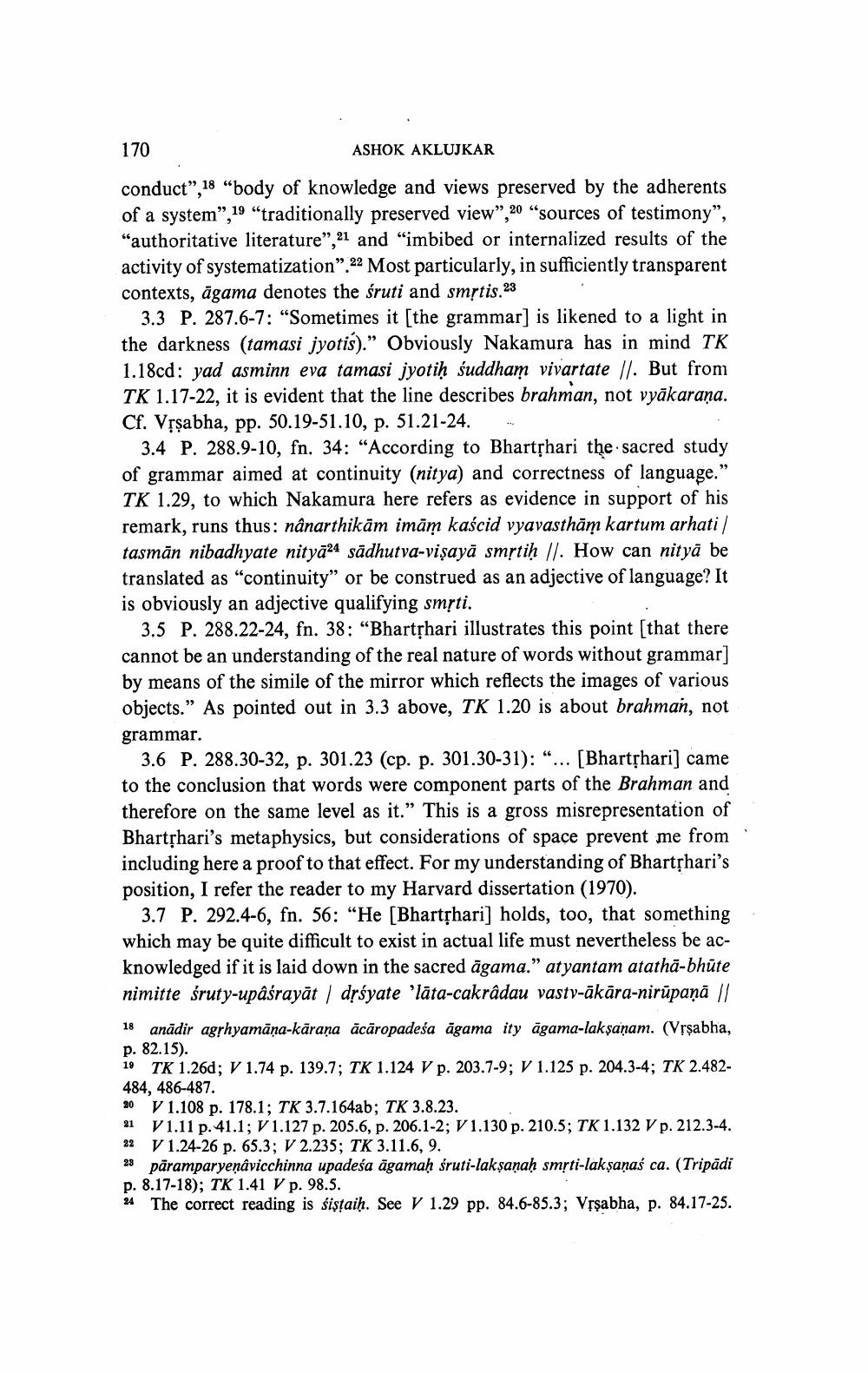________________
170
ASHOK AKLUJKAR
conduct”, 18 "body of knowledge and views preserved by the adherents of a system”,19 "traditionally preserved view”, 20 “sources of testimony”, "authoritative literature”, 21 and “imbibed or internalized results of the activity of systematization". 22 Most particularly, in sufficiently transparent contexts, agama denotes the śruti and smrtis.23
3.3 P. 287.6-7: "Sometimes it (the grammar] is likened to a light in the darkness (tamasi jyotis).” Obviously Nakamura has in mind TK 1.18cd: yad asminn eva tamasi jyotiḥ śuddham vivartate //. But from TK 1.17-22, it is evident that the line describes brahman, not vyākaraṇa. Cf. Vrşabha, pp. 50.19-51.10, p. 51.21-24. -
3.4 P. 288.9-10, fn. 34: “According to Bhartshari the sacred study of grammar aimed at continuity (nitya) and correctness of language.” TK 1.29, to which Nakamura here refers as evidence in support of his remark, runs thus: nânarthikām imāņ kaścid vyavasthāṁ kartum arhati | tasmān nibadhyate nityā24 sädhutva-vişayā smrtiḥ //. How can nityā be translated as "continuity” or be construed as an adjective of language? It is obviously an adjective qualifying smrti.
3.5 P. 288.22-24, fn. 38: “Bhartshari illustrates this point that there cannot be an understanding of the real nature of words without grammar] by means of the simile of the mirror which reflects the images of various objects.” As pointed out in 3.3 above, TK 1.20 is about brahman, not grammar.
3.6 P. 288.30-32, p. 301.23 (cp. p. 301.30-31): “... [Bhartshari) came to the conclusion that words were component parts of the Brahman and therefore on the same level as it.” This is a gross misrepresentation of Bhartshari's metaphysics, but considerations of space prevent me from including here a proof to that effect. For my understanding of Bhartshari's position, I refer the reader to my Harvard dissertation (1970).
3.7 P. 292.4-6, fn. 56: “He [Bhartshari] holds, too, that something which may be quite difficult to exist in actual life must nevertheless be acknowledged if it is laid down in the sacred āgama." atyantam atathā-bhūte nimitte śruty-upâśrayāt drśyate 'lāta-cakradau vastv-ākāra-nirūpaņā // 18 anādir agrhyamāņa-kärana ācāropadeśa āgama ity āgama-laksanam. (Vrsabha, p. 82.15). 19 TK 1.26d; V 1.74 p. 139.7; TK 1.124 V p. 203.7-9; V 1.125 p. 204.3-4; TK 2.482484, 486-487. 20 V 1.108 p. 178.1; TK 3.7.164ab; TK 3.8.23. 21 V1.11 p. 41.1; V 1.127 p. 205.6, p. 206.1-2; V 1.130 p. 210.5; TK 1.132 V p. 212.3-4. 22 V 1.24-26 p. 65.3; V 2.235; TK 3.11.6, 9. 28 päramparyenávicchinna upadeśa āgamaḥ śruti-lakṣaṇaḥ smrti-lakṣaṇaś ca. (Tripadi p. 8.17-18); TK 1.41 V p. 98.5. 24 The correct reading is śişțaiḥ. See V 1.29 pp. 84.6-85.3; Vţşabha, p. 84.17-25.




